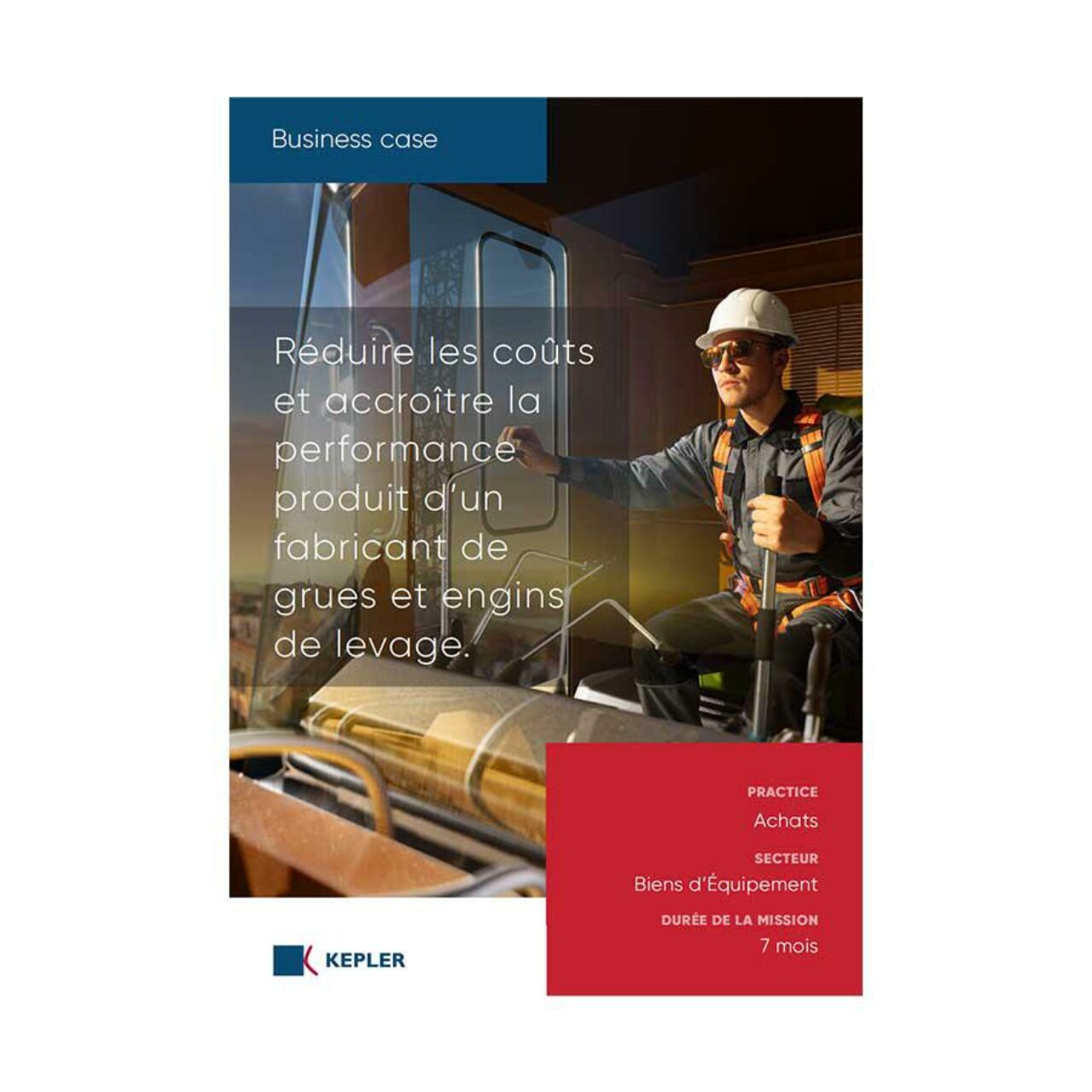
Coping with rising prices by means of a functional analysis and capturing value through Procurement-Innovation articulation
An operational lever with a strong strategic impact
Through a methodological approach used upstream and mobilizing the Value Analysis, the organization proceeds to a re-engineering, exploring the product, and re-examining the design choices in the light of the evolution of strategic and economic challenges and the maturity of technologies.
This approach can be orchestrated in three steps.
1. Acting on components for quick gains
The first step is to confine the risk by targeting the impacted technical scope and determining the work base. In practice: focusing on front-runner products.
- Assessing the impact of component price increases on the product cost price to determine the cost reduction objective (CRO).
- Then applying Pareto principle to select the 20% of components that stand for 80% of the product cost price.
Note: all the components of this set are not necessarily impacted by an increase. But the rise in component prices may eventually be absorbed by cost reductions on components not impacted by the price increase and significantly contributing to the overall product price cost.
What must be understood here is that focusing only on the economic factor is ineffective. It is also and jointly necessary to:
- Consider the functional contribution of the targeted components (contribution to added value for the client)
- Explore the technological context of these components, in other words:
- what other components are they connected to in the product architecture?
- what is the chosen technical principle that requires the use of the component?
The simultaneous exploration of these factors – economic, functional and technological – allows to consider alternative technical and economic scenarios to the existing design of the product.
To spread the reflection to the scope of possibilities, it is necessary to address all the challenging levels of the product, from component to function.
At the component level, you can question its characteristics (dimensions, material) by challenging the specifications of the product.
- What are the required service values / level of performance?
Frequently, CDCs are formulated in terms of technical solutions, thus reducing any flexibility range. You should go back to a functional expression of the need and ask yourself:
- What’s the point?
- What would be enough?
- What are the thresholds, the critical values?
- What are the regulatory aspects requirements?
Shifting through the specifications starting with the “critical” components allows you to spot the due need and track down every over-sizing.
You should keep in mind that each component is related to others within the architecture of the product, by assembly functions generating process costs (welding, crimping, etc.). Any component modification must therefore be associated to an impact study on these assembly functions to validate the potential savings considered and check whether the changes required at the level of the process increase or reduce the savings on the component.
At the end of the operation, you can consider a reduction in the mass of material used or substitutions of materials for the component. Since these gains are generally relatively quick to implement, they are considered as "Quick wins"!José Pendje, Value Analysis Expert
2. Optimizing the architecture of subassemblies to achieve technical savings
By considering the other components to which our component (initial target) is connected, you can often identify a “design loop” within a technical subassembly.
This design loop is itself a solution that responds to a technical function such as: “maintaining component A and component B.”
Such a loop is an index of potential optimization. It corresponds to “the part that holds the part that holds the part…” In theory, at least one component could be removed.
Example: to maintain A and B, you could drill a hole in both A and B and use a screw. Or you could just as well stick A and B and remove the screw, the bolt and the drilling operation of A and B?
Note: at the time when the choices determining the product’s design were made, there may not have been a more optimum technical solution. But technical innovation is fast and there might be, since that time, new and less expensive solutions that provide the same service.
We have previously mentioned the function’s level by addressing, from the component perspective, the functional specifications to find the Due need for the level of performance required. In this operation, you trace back from the technical solution, in the present case, the design loop to which the targeted component belongs, towards the function (the service to be provided by the product).
- WHAT is this technical solution AIMED AT?
- What is the technical Due need to meet this requirement, or HOW to meet this requirement with the best technical and economic compromise?
3. Re-qualifying the client’s need to open functional innovation opportunities
To cover all the cost reduction opportunities, it is finally necessary to operate the “top-down” approach from function to solutions. Firstly, you accurately qualify the function, then you explore HOW to address it the technical level.
Thus, you can “re-qualify” the function.
- Does the performance level determined for a function correspond to the one actually expected by the user?
- Would lowering the performance level of this function have an impact on sales or perceived quality?
- What savings would this functional revision generate?
Sometimes the validation of the function raises the question of its obsolescence. It may be appropriate to abandon a function that no longer brings real added value to the product (the savings made can then be significant).
Conversely, considering a new approach of this function could allow you to raise the selling price.
Some features with high added value can incur a reduced cost price where other features with lower value, from the client’s perspective, incur significant costs (c.f. Kano, Blue Ocean). The possibility of raising the selling price or the sales volume while maintaining the cost price flat allows to increase the operating income.
The mutations of our societies have generated new consumer expectations.
New usages appear and along them, new values are revealed, unveiling opportunities for you to align to. The product specifications are “enhanced” and benefit from exceeding the “quality/price” ratio objective by integrating new functions, like the so-called “RSE” or functions linked to digital transition or “connectivity”.
The possibility of replacing a component with a more “sustainable” component (reusable, pollution free) can bestow the product with undeniable added value for the client and bring a significant competitive advantage. Ironically, you could be led to substitute a component by a more expensive component and this additional cost could be substantially dampened by a higher selling price and the acquisition of additional market shares. There you can see the eco-design dimension embedded in our approach and how it reshapes the value distribution in the product architecture.
Do not forget that your cost reduction efforts aim to preserve the margin. In this respect, the search for opportunities to create value likely to increase the margin is also a lever to counter the rise in component prices.
Tracing back to the functions level allows you to gain perspective and to consider alternative technological principles – technological innovation – to respond to the service to be rendered. A new principle is then substituted for the technical principle initially used. If the implementation of such a substitution cannot always be considered in the short term (due to necessary validation tests or process modifications, etc.), it can still generate savings or a significant breakup gain.
A functional innovation approach can also respond to the inflationary problem: increasing the product margin is a possibility to absorb the increase in component prices.
Return on investment
If the Functional Analysis approach does not necessarily make it possible to completely compensate for the components price rise in the short term, it certainly succeeds in the medium term, because the savings or gains acquired are “sustainable” as they are part of the very architecture of the product.
Three requirements for implementation
- An initiative from general management or a function with cross-functional prerogatives (procurement department, management control, economic performance program)
- The possibility of mobilizing within about ten workshops the main stakeholders involved in the technical, economic and functional performance of the product (DO, R&D, Marketing, Procurement)
- A Value Analysis expert to lead the methodology and lead the process
The expected benefits
Beyond the methodological support, the approach enables to stimulate a state of mind at the teams level: learning to improve their reactions facing adversity, opening up to re-reflection, overcoming preconceptions, rationalizing discussions and documenting points of view.
This approach brings them to face the obstacle and find the courage to collectively consider all the possible options to overcome it.
It is also an approach that promotes the decompartmentalization of business lines and develops agility through cross-functional collaboration.
- Results observed on our RTC missions: 15-30% cost reduction on BOM.

Réduire les coûts et accroître la performance produit d’un fabricant de grues et engins de levage
Notre client, un fabricant de grues à montage par éléments souhaite réduire les coûts d’acquisition et de fabrication des chariots tout en en optimisant la performance. KEPLER accompagne les chefs de projets dans l’animation de chantiers d’Analyse de la Valeur et l’animation des charnières métiers de façon à tirer le meilleur parti des expertises individuelles et permettre l’exploration de nouveaux gisements de valeur.


